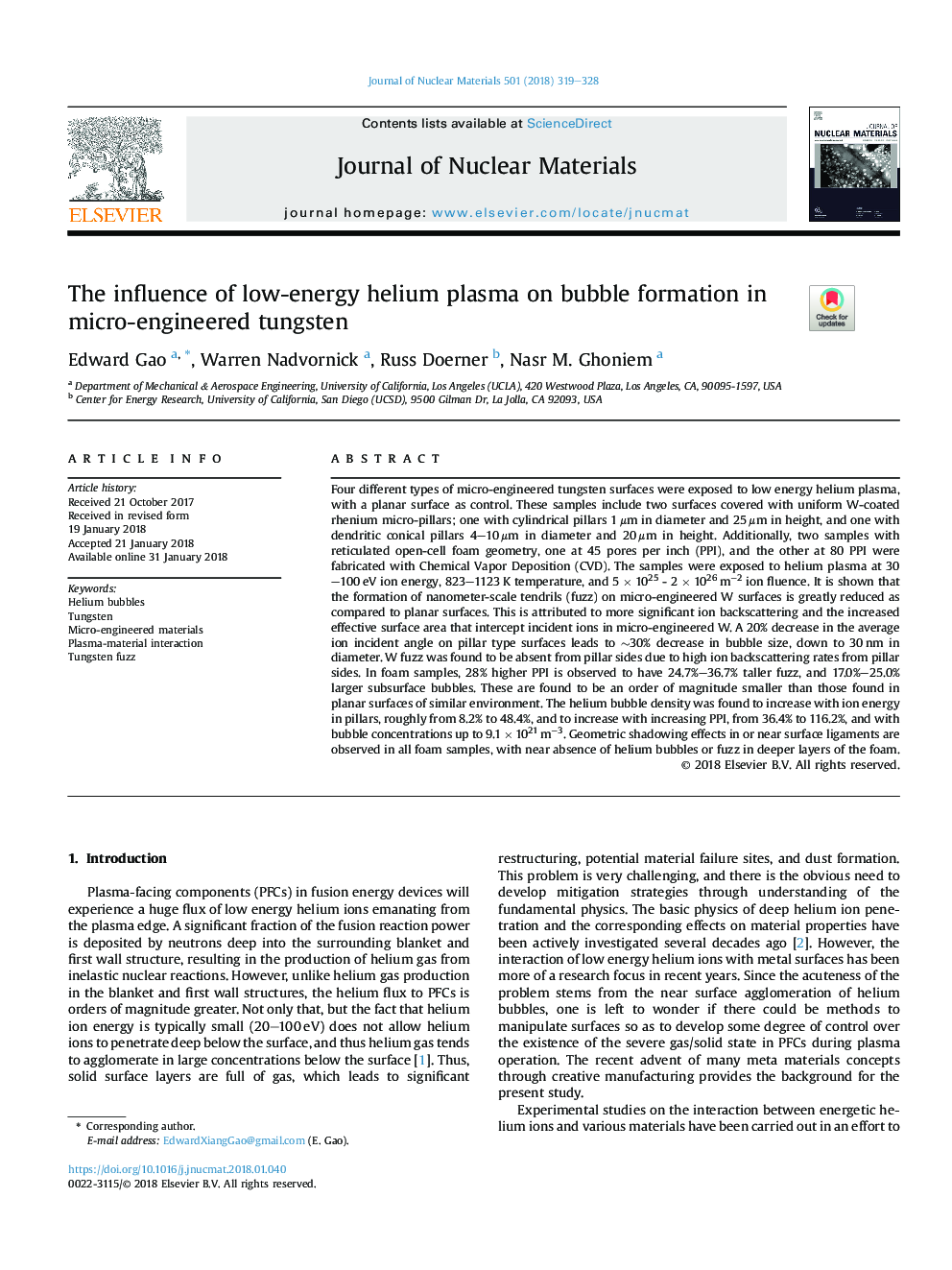| کد مقاله | کد نشریه | سال انتشار | مقاله انگلیسی | نسخه تمام متن |
|---|---|---|---|---|
| 7963413 | 1514145 | 2018 | 10 صفحه PDF | دانلود رایگان |
عنوان انگلیسی مقاله ISI
The influence of low-energy helium plasma on bubble formation in micro-engineered tungsten
ترجمه فارسی عنوان
تأثیر پلاسمای هلیم کم انرژی بر تشکیل حباب در تنگستن میکرو مهندسی
دانلود مقاله + سفارش ترجمه
دانلود مقاله ISI انگلیسی
رایگان برای ایرانیان
موضوعات مرتبط
مهندسی و علوم پایه
مهندسی انرژی
انرژی هسته ای و مهندسی
چکیده انگلیسی
Four different types of micro-engineered tungsten surfaces were exposed to low energy helium plasma, with a planar surface as control. These samples include two surfaces covered with uniform W-coated rhenium micro-pillars; one with cylindrical pillars 1â¯Î¼m in diameter and 25â¯Î¼m in height, and one with dendritic conical pillars 4-10â¯Î¼m in diameter and 20â¯Î¼m in height. Additionally, two samples with reticulated open-cell foam geometry, one at 45 pores per inch (PPI), and the other at 80 PPI were fabricated with Chemical Vapor Deposition (CVD). The samples were exposed to helium plasma at 30-100â¯eV ion energy, 823-1123â¯K temperature, and 5 à 1025 - 2 à 1026â¯mâ2 ion fluence. It is shown that the formation of nanometer-scale tendrils (fuzz) on micro-engineered W surfaces is greatly reduced as compared to planar surfaces. This is attributed to more significant ion backscattering and the increased effective surface area that intercept incident ions in micro-engineered W. A 20% decrease in the average ion incident angle on pillar type surfaces leads to â¼30% decrease in bubble size, down to 30â¯nm in diameter. W fuzz was found to be absent from pillar sides due to high ion backscattering rates from pillar sides. In foam samples, 28% higher PPI is observed to have 24.7%-36.7% taller fuzz, and 17.0%-25.0% larger subsurface bubbles. These are found to be an order of magnitude smaller than those found in planar surfaces of similar environment. The helium bubble density was found to increase with ion energy in pillars, roughly from 8.2% to 48.4%, and to increase with increasing PPI, from 36.4% to 116.2%, and with bubble concentrations up to 9.1 à 1021â¯mâ3. Geometric shadowing effects in or near surface ligaments are observed in all foam samples, with near absence of helium bubbles or fuzz in deeper layers of the foam.
ناشر
Database: Elsevier - ScienceDirect (ساینس دایرکت)
Journal: Journal of Nuclear Materials - Volume 501, 1 April 2018, Pages 319-328
Journal: Journal of Nuclear Materials - Volume 501, 1 April 2018, Pages 319-328
نویسندگان
Edward Gao, Warren Nadvornick, Russ Doerner, Nasr M. Ghoniem,
